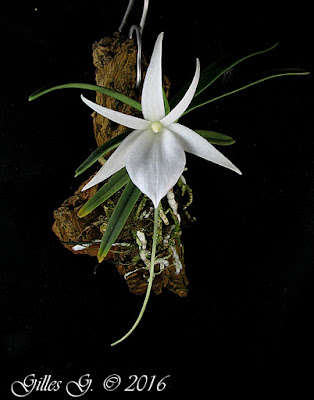Angraecum rutenbergianum is native to Madagascar. This orchid is widespread in the central regions of the island in the area around Antananarivo where it grows in humid, evergreen forests as an epiphyte on tree trunks , but is found more often on rocks in areas with definite wet and dry seasons at 1500-2200 m.
Angraecum rutenbergianum also called as Rutenberg's Angraecum, Angraecum catati, Jumellea rutenbergiana, Perrierangraecum rutenbergianum, is a species of the genus Angraecum. This species was described by Friedrich Wilhelm Ludwig Kraenzlin in 1882.
IDENTIFY ANGRAECUM RUTENBERGIANUM ORCHID PLANT
Angraecum rutenbergianum is native to Madagascar. This orchid is widespread in the central regions of the island in the area around Antananarivo where it grows in humid, evergreen forests as an epiphyte on tree trunks , but is found more often on rocks in areas with definite wet and dry seasons at 1500-2200 m.
It is a miniature sized, cool to cold growing lithophyte or epiphyte with a short stem carrying stiff, leathery, somewhat keeled, dull dusty green leaves.
Rutenberg's Angraecum blooms in the spring through summer on a axillary, 3 cm long, single flowered inflorescence.
ANGRAECUM RUTENBERGIANUM ORCHID PLANT CARE AND CULTURE
Cultural information should only be used as a guide, and should be to be adapted to suit you. Your physical location; where you grow your plants, how much time you have to devote to their care, and many other factors, will need to be taken into account. Only then can you decide on the cultural methods that best suit you and your plants.
Light:
Angraecum rutenbergianum needs a light level of 20000-30000 lux. Light should be filtered or diffused, and plants should not be exposed to direct midday sun. Strong air movement should be provided at all times.
Temperature:
Summer days temperature at average 23-25°C, and nights temperature at average 13-14°C, with a diurnal range of 10-11°C.
Humidity:
Rutenberg's Angraecum need the humidity of 75-80% most of the year, dropping to near 65% for a short time in spring.
Substrate, growing media and repotting:
Angraecum rutenbergianum may be grown in a shallow, well-drained pot or basket that is filled with a light, fluffy, mix of fir bark or shredded tree fern to which perlite or sphagnum has been added. Adding charcoal to the mix helps hold the medium open and keeps it from becoming sour. It might be preferable to use fine tree-fern fiber as the base for the potting mix, since it deteriorates more slowly than fir bark. Some growers report growing plants successfully in nothing but perlite or sponge rock. Some growers use a completely non-organic medium after plants reach blooming size so that the roots will not need be disturbed as often.
The longer lasting the medium, the less often the plant will need to be repotted. Some orchids from this region may enter a period of no-growth for 2, or even up to 4, years after being disturbed. However, the roots cannot tolerant stale conditions, so plants should be repotted immediately if the medium starts to break down. When repotting is necessary, it is best done just as new roots start to grow. This allows the plant to become reestablished in the shortest possible time.
If mounted, the slab need not be any larger than 16 cm long by 6 cm wide. If mounted, however, plants must be watered at least once daily except in winter when a cooler, drier rest is indicated.
Watering:
Rainfall is very heavy from late spring to early autumn. Amounts then decrease fairly rapidly at the beginning of the 5-month dry season, which lasts from late autumn to early spring. Cultivated plants should be watered heavily while actively growing. Water should be reduced after new growth is completed in autumn.
Fertilizer:
1/4-1/2 recommended strength, applied weekly when plants are actively growing. You can use a balanced fertilizer all year. Others, you can also use a high-nitrogen fertilizer from spring to midsummer and then switch to a high-phosphate formula in late summer and autumn.
Rest period:
Winter days temperature at average 18-19°C, and nights average 7-8°C, with a diurnal range of 11-12°C. Angraecum rutenbergianum plants need less water in winter, but they should not dry out completely or stay dry for long periods. Somewhat regular early-morning misting between infrequently light waterings should provide sufficient moisture in most growing areas. Fertilizer should be reduced or eliminated until new growth starts and heavier watering is resumed in spring.















COMMENTS